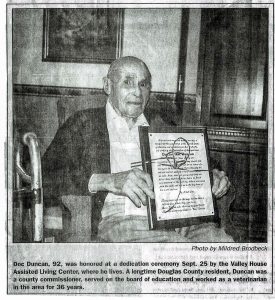Beeman-Duncan Ranch, Part II


“Doc” Duncan at 92 in 2001. Picture shows him being honored for 36 years of Douglas County service as commissioner, school board member, and trusted veterinarian. (Photo courtesy of Mildred Brodbeck).
Born in Red Lodge, Montana in 1909 to mining industry magnate W. G. Duncan, William G. II (Bill) came to Sedalia in 1918 when his dad bought the old Beeman homestead. W.G. treasured the rural beauty and appeal of his new landscape and worked with Bill to preserve it for posterity.
Though Bill’s father was already losing his vitality when the ranch was acquired, father and son collaborated to retain its character and the environment it offered as a welcoming shelter for local wildlife.
Young Bill grew up in Sedalia, attending its only grade school, then moving on to Englewood for high school when his parents purchased a conventional home on the 3700 block of South Galapagos Street. (The home later would become the Maggie Martin Preschool.) The year 1932 found him graduating from veterinary school at Colorado A&M in Fort Collins, known today as Colorado State University.
Bill earned the nickname “Doc” and married a St. Louis gal, Gertrude Cavalier in 1940, returning with her to the ranch in 1942 with another William (III) in tow. From that point on, Doc became one of Douglas County’s most visible leaders. A gentle man who loved all things natural and the serenity of the range, he could be found at his happiest communing with local wildlife and tending flowers on his land. He was once compared to Henry David Thoreau, famous for his epic Walden Pond adventure.
Douglas County viewed him as one of its benevolent giants, as much for his balanced, seasoned, rational thinking and organizational skills. Doc’s ethics were pronounced – a distinct, firm notion of right and wrong.
So recognized, Doc was elected to the school board in the 1950s and then later to several terms as county commissioner. His school board service was during tumultuous times of redistricting and reorganization.
As county commissioner (1977-1985), he was hip deep in other growth challenges, seminal issues concerning land, some that would later become Highlands Ranch. He died at age 92.
William III the youngest, flourished at and through the Beeman-Duncan Ranch as well. His early memories were of sketching animals at the family kitchen table. No small resource, his doctor dad was a stickler on attention to detail in those drawings, knowing as he did, every appendage of local animals.
Attending Denver University in the early ‘60s, William III fell under the thrall of William Sanderson, a noted artist who persuaded him to change his major. That inspiration laid the groundwork for his path to professional artistry, concentrating on sculpture. A perfectionist, William III was once quoted as saying, “I’m always a little dissatisfied by what I do.”
Significantly, William III and his artistry were deeply impacted by the wizened locals of Plum Creek. He cited neighboring ranchers and cattlemen as having opened his eyes for a deeper, more meaningful love of the west. Among them, William III mentioned the tall tales of Vernon Wyatt who “would talk hours on end about bear hunts – I can still smell the smoke from his pipe.” Velva Bains Wyatt, Vern’s daughter and another Douglas County legend herself, can relate on both counts.
Located at the intersection of Highways 67 and 105, bisected by West Plum Creek and 475 acres in total, the ranch has since been transferred to the Douglas County Land Conservancy.
As it turns out, The Connection serves residents of the Wildcat Mountains, a name pioneers and historians gave to the high country paralleling I-25 from Highlands Ranch and Lone Tree south to Castle Rock. Since the first territorial road (Daniels Park Road) bisected our mountains, there was no shortage of colorful characters parading through what are now private properties on the ridges of Douglas County. We bring these grizzled and gutsy settlers alive again, vividly sharing their stories of grit and achievement in these Castle Pines.
By Joe Gschwendtner; courtesy photo